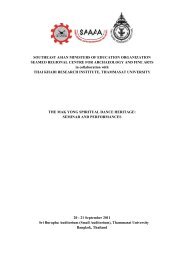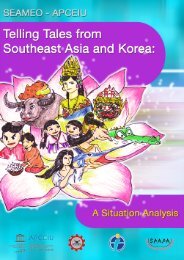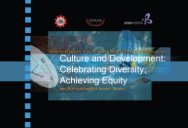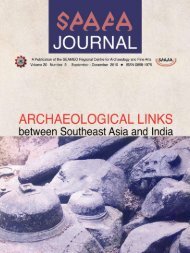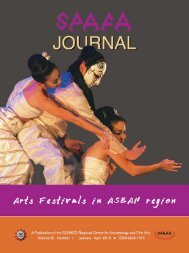on Culture & Development - Seameo-SPAFA
on Culture & Development - Seameo-SPAFA
on Culture & Development - Seameo-SPAFA
- No tags were found...
You also want an ePaper? Increase the reach of your titles
YUMPU automatically turns print PDFs into web optimized ePapers that Google loves.
98Introducti<strong>on</strong>The overall aim of Day 4 is to identifywhat cultural factors individuals,professi<strong>on</strong>als, organizati<strong>on</strong>s andinstituti<strong>on</strong>s may bring to the planningprocess. C<strong>on</strong>tinuing the journey ofcritical reflecti<strong>on</strong> and analysis, Day 4activities have been selected toencourage an explorati<strong>on</strong> of values,ideas, beliefs, attitudes andbehaviours am<strong>on</strong>g the many differentstakeholders involved. The challengewas to find ways to unpack thiscultural baggage in the variousc<strong>on</strong>texts in which the workshops weretaking place, and to facilitatediscussi<strong>on</strong> <strong>on</strong> sometimes difficult,pers<strong>on</strong>al or sensitive topics.Understanding that participants mayeasily be taken out of their comfortz<strong>on</strong>es, and acknowledging Chambers’(2005) warning that participatoryactivities can, “…lift the lids fromdomains that are unpleasant, hidden,private, or dangerous”, the aim was tofind activities that could bec<strong>on</strong>structive whilst n<strong>on</strong>-threatening.The alternative activities orapproaches presented in this sec<strong>on</strong>dediti<strong>on</strong> of the Guidelines are the resultof observati<strong>on</strong>s made during each ofthe 6 workshops. On-going m<strong>on</strong>itoringby the team of facilitators, feedbackfrom the daily reviews as well asoverall group dynamics very muchinfluenced our decisi<strong>on</strong>s about whichof the activities to use, when, and howto use them. Approaching the issuesraised through shorter, snappieractivities which encouraged laughterproved effective. As a starting pointwe decided to focus <strong>on</strong> theorganisati<strong>on</strong>s and instituti<strong>on</strong>srepresented by the group. This wasfollowed by a gradual move to theindividual level and an emphasis <strong>on</strong>pers<strong>on</strong>al agency; leading to arealisati<strong>on</strong> that what we choose to door not to do does in fact, make adifference.Activity 4.3 explores our percepti<strong>on</strong>sabout the power, missi<strong>on</strong>, scope ofwork, work practices, rules,regulati<strong>on</strong>s, procedures and so <strong>on</strong> ofthe different developmentstakeholders represented by thegroup. Each organisati<strong>on</strong>al group not<strong>on</strong>ly defines itself but is also asked toview itself through the eyes of anoutsider. The activity rapidly uncoversthe boundaries we c<strong>on</strong>sciously orunc<strong>on</strong>sciously create regarding ourwillingness or reluctance to engagewith certain “others”, and theinfluence this can have over what kindof interacti<strong>on</strong> actually takes place



